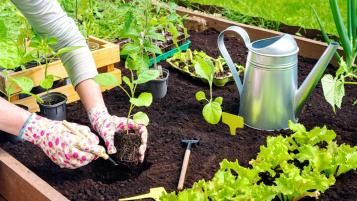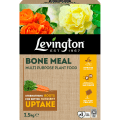_0.jpg)
Growing vegetables in raised beds is one of the simplest ways to make a vegetable garden. With their neat geometric shape, raised vegetable beds add style and structure to any garden. You can make them high enough to work on without needing to bend down or kneel, so they’re ideal for anyone with back or knee problems, and they’re a great solution for gardens with poor soils.
Advantages of raised bed gardening
One of the biggest advantages of gardening in raised beds is that the soil in the beds is totally under your control. This is especially useful for growing vegetables, which often have very specific soil requirements. When growing vegetables in the ground, you have to plant what will grow well in your soil if you want a good harvest. Growing fruit and veggies in raised beds has no such restrictions – if you want to, you can create a raised bed filled with ericaceous compost for acid-loving plants like blueberries and another bed filled with light, sandy soil for vegetables like carrots that need good drainage.

Because we generally work on raised beds from the sides, the soil doesn’t get compacted by being walked on, so it retains a good structure and drains well. This allows plants to develop strong, healthy root systems.
Raised vegetable beds are less strain on your back and knees, and you can build them to whatever height suits you. They’re ideal for gardeners in wheelchairs or anyone who has difficulty bending or kneeling for long periods.
Points to consider when making a raised vegetable bed
Before you start to make a raised garden bed, think about its position. Most fruits and vegetables need at least six hours of sunlight a day to do well so, if possible, site your raised bed where it will get plenty of direct sunlight and will not be shaded by trees or houses. If this isn’t possible, you can still grow vegetables in a raised bed, but you will need to do a bit more research and plant vegetables that can cope with shade, such as lettuce and kale.
You can make a raised vegetable bed from a wide range of materials, including timber, bricks or even galvanised metal sheeting. Decking boards or untreated railway sleepers are a popular choice. You can also buy raised bed kits in a range of materials, shapes and sizes to suit your space.

If you are using timber to make your raised bed, it’s a good idea to line the inside faces of your raised bed with plastic sheeting. If the wood has been treated to make it weatherproof, the lining helps prevent chemicals from the wood from leaching into the soil. If the wood is untreated, plastic lining keeps wet soil from contact with the wood, prolonging the life of your raised bed. Don’t line the base of the bed, as this will stop it draining properly. We also recommend adding logs to the bottom of your raised bed and then layering newspaper on top to help with drainage and ensuring enough oxygen can circulate around plant roots.
How to make a wooden raised bed in six steps
- Once you’ve decided where your raised bed is to be placed, clear the ground, remove the turf and get rid of any weeds. Dig the area over, this means to turn the soil over, so it become loose, aerated and less lumpy. Remove any large stones and level the ground off.
- Mark out the corners of the bed by hammering square wooden posts into the ground, using a set square and string to make sure the corners are at right angles. If your raised bed is longer than 3m, you will probably need to add extra supporting posts along the sides. Don’t make your raised bed too wide, or you won’t be able to reach the centre without walking on it. As a guide, raised beds accessible from both sides should be no more than 1.5m wide, or 75cm wide if only accessible from one side, and at least 45cm deep. Think about path widths too – allow at least 45cm width to get a wheelbarrow down a path, and if you need wheelchair access, make the path at least 1m wide.
- Create rectangular wooden frame by fixing panels to the posts using long screws.
- Line the inside faces of the wooden frame with plastic sheeting to prevent any chemicals leaching into the soil, and to keep wet soil from coming into contact with the wood.
- Fill the bed with a mixture of sand, topsoil and garden compost or another organic soil improver. Leave the soil to settle for a couple of weeks before planting.
- If your raised bed is on a hard, impermeable surface such as paving or concrete, drill holes low down on the sides of the bed for drainage and cut slits in any plastic liners.

Growing vegetables in raised beds
To prepare your raised bed for planting vegetables, first decide what you want to grow in it. Raised beds are ideal for vegetables that need different soil conditions to the soil in your garden. If your soil is heavy clay, a raised vegetable bed allows you to grow veg and herbs that need light free-draining soil. If you garden on alkaline or chalky soil, you could use a raised bed to grow ericaceous plants like blueberries and cranberries which only grow well in acidic soils.
When choosing what to plant in your raised beds, it’s best to start with vegetables that don’t get too tall and won’t need extra staking to protect them against strong winds. Shallow-rooted vegetables like carrots, beetroot, onions, lettuce, dwarf beans, spinach, kale, herbs, potatoes and courgettes are among the best vegetables to grow in a raised bed.
Fill your raised bed with a mix of topsoil, organic matter (e.g. garden compost or well-rotted farmyard manure) and sharp sand. The proportions will vary depending on what you are planting, but a typical mix is three parts organic matter, two parts sharp sand and seven parts topsoil. For plants that like free-draining soil, increase the amount of sand in the mix to four parts.
When setting out your plants, think about how the sun moves during the day and make sure that smaller plants won’t end up being shaded out by taller plants as they grow. In the UK, this means placing taller plants on the northerly side of your raised bed and shorter plants towards the southerly side.
It’s important to replenish the nutrients in the soil of your raised bed, especially if you’re growing heavy-feeding crops like potatoes. Add a slow-release fertiliser like Fish Blood and Bone to the soil in spring, and feed your plants during the growing season in the same way as you would for plants in the ground.
Raised beds dry out faster than beds in the ground, so water regularly, particularly in dry periods.
Mulch your raised beds in autumn or spring using organic material like leaf mould, compost or well-rotted farmyard manure. As well as improving soil structure and nutrient levels, this also helps soils retain moisture.

FAQs
Should you line a raised bed?
Lining the inner sides of a raised bed stops chemicals from treated timber leaching into the soil. A plastic liner also keeps wet soil from touching the timber, prolonging the life of the raised bed. Don’t line the base of a raised bed, as this stops the soil draining properly.
What’s the easiest veg to grow in a raised bed?
You can grow most vegetables in a raised bed, but avoid tall plants that need staking, like cordon tomatoes, as these will be more exposed to strong winds in a raised bed. Shallow-rooted vegetables that need a soil depth of 30-45cm are ideal for raised beds.
10 easy vegetables to grow in raised beds:
- Lettuce
- Radishes
- Spinach
- Spring onions
- Garlic
- Carrots
- Peppers
- Peas
- Dwarf beans
- Courgettes
Do you have any impressive raised beds in your garden? Perhaps you have used different materials and methods to what we have discussed here? If that is the case then we would love to hear about it @LoveTheGarden.








